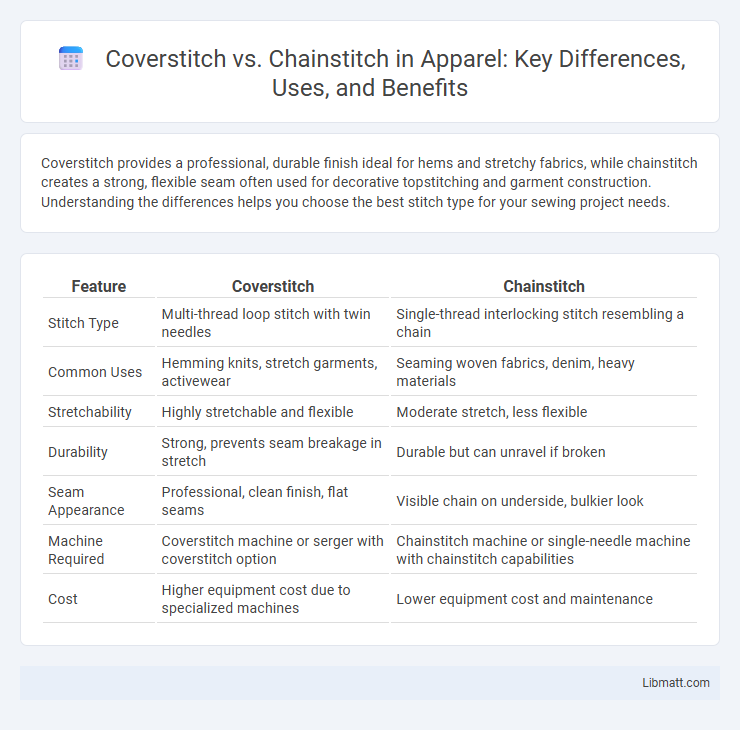Coverstitch provides a professional, durable finish ideal for hems and stretchy fabrics, while chainstitch creates a strong, flexible seam often used for decorative topstitching and garment construction. Understanding the differences helps you choose the best stitch type for your sewing project needs.
Table of Comparison
| Feature | Coverstitch | Chainstitch |
|---|---|---|
| Stitch Type | Multi-thread loop stitch with twin needles | Single-thread interlocking stitch resembling a chain |
| Common Uses | Hemming knits, stretch garments, activewear | Seaming woven fabrics, denim, heavy materials |
| Stretchability | Highly stretchable and flexible | Moderate stretch, less flexible |
| Durability | Strong, prevents seam breakage in stretch | Durable but can unravel if broken |
| Seam Appearance | Professional, clean finish, flat seams | Visible chain on underside, bulkier look |
| Machine Required | Coverstitch machine or serger with coverstitch option | Chainstitch machine or single-needle machine with chainstitch capabilities |
| Cost | Higher equipment cost due to specialized machines | Lower equipment cost and maintenance |
Introduction to Coverstitch and Chainstitch
Coverstitch and chainstitch are essential sewing techniques used to create durable and stretchy hems, often found in knit garments. Coverstitch features two or more needles and a looper thread underneath, producing a professional finish with parallel stitch lines on top and a looper thread holding the fabric layers together. Chainstitch involves a single or double needle forming chain-like loops on the fabric's underside, offering flexibility but less stability compared to coverstitch.
What is a Coverstitch?
A coverstitch is a type of stitch commonly used in garment construction to create professional hems and stretchy seams, characterized by parallel rows of stitching on the top and a looper thread on the underside that covers the seam allowance. It provides durability and elasticity, making it ideal for knit fabrics and activewear. Your choice of coverstitch offers a clean, finished look while allowing fabric to maintain its stretch and comfort.
Understanding Chainstitch Basics
Chainstitch uses a single thread looped through the fabric, creating flexibility but prone to unraveling if cut, making it ideal for temporary seams or decorative finishes. Coverstitch features double or triple needles and a looper thread, providing strong, stretchable seams commonly used in activewear and hems. Understanding chainstitch basics helps you choose the right stitch for your project's durability and finish.
Core Differences Between Coverstitch and Chainstitch
Coverstitch features two or more needles creating parallel lines on the fabric's front and a looper thread forming a series of interlocking loops on the back, ideal for hemming stretch fabrics and providing durability with flexibility. Chainstitch uses a single needle and looper to form chain-like loops on the underside, offering a decorative, strong stitch but with less elasticity and greater tendency to unravel. The core difference lies in the stitch formation: coverstitch offers a balanced front-and-back finish suited for stretch seams, while chainstitch produces a single-thread chain loop often used for reinforcement or decorative topstitching.
Strength and Durability Comparison
Coverstitch offers superior strength and durability due to its double or triple needle construction, distributing tension evenly across the fabric and reducing the risk of seam failure. Chainstitch, while flexible and commonly used for hemming, tends to unravel more easily under stress, making it less durable for heavy-use garments. For long-lasting, high-stress seams, coverstitch is the preferred option, particularly in activewear and stretch fabrics.
Best Uses for Coverstitch
Coverstitch is ideal for hemming knit fabrics and creating professional-looking finishes on garments like t-shirts, activewear, and swimwear due to its flexibility and durability. It provides a smooth, stretchy seam that resists unraveling, making it perfect for seams that require frequent stretching or movement. Unlike chainstitch, coverstitch offers double or triple needle options that enhance seam strength and aesthetic appeal in high-wear areas.
Ideal Applications for Chainstitch
Chainstitch is ideal for applications requiring stretch and flexibility, such as activewear, swimwear, and lightweight fabrics. This stitch provides a durable seam that can withstand frequent movement and washing, making it perfect for garments with elastic properties. Your choice of chainstitch enhances comfort and longevity in clothing designed for dynamic activities.
Ease of Use and Machine Compatibility
Coverstitch machines offer superior ease of use for beginners, featuring stitch options that are straightforward to set up and adjust. Chainstitch machines demand more precise tension control and threading skills, making them better suited for experienced users. Your choice should consider the specific fabric compatibility and machine capabilities to ensure optimal stitching results.
Cost Implications: Coverstitch vs Chainstitch Machines
Coverstitch machines generally have higher upfront costs compared to chainstitch machines due to their complex mechanisms and ability to produce professional hems and seams ideal for stretch fabrics. Chainstitch machines are more affordable and require less maintenance, making them cost-effective for basic stitching but may compromise durability in high-stress areas. Choosing the right machine can impact your production budget, with coverstitch offering long-term value in quality and strength while chainstitch suits simpler projects and lower initial investment.
Choosing the Right Stitch for Your Sewing Project
Selecting the right stitch depends on the fabric type and project purpose, where coverstitch offers superior stretch and durability ideal for knitwear and hems. Chainstitch provides a flexible, decorative seam useful for lightweight fabrics but may unravel over time if not finished properly. Prioritizing project requirements like elasticity, seam strength, and finish ensures optimal functionality and garment longevity.
Coverstitch vs Chainstitch Infographic

 libmatt.com
libmatt.com